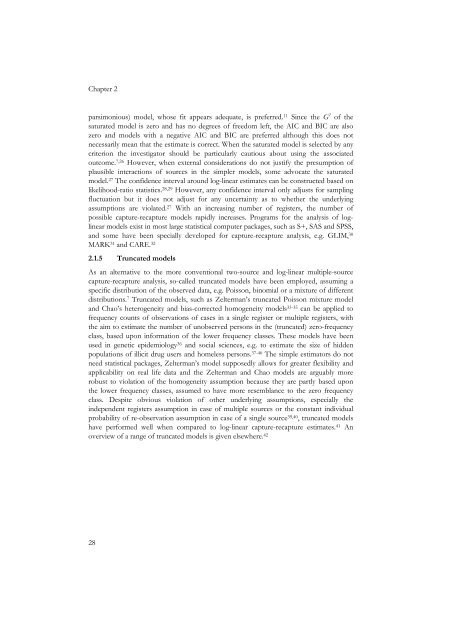Rob van Hest Capture-recapture Methods in Surveillance - RePub ...
Rob van Hest Capture-recapture Methods in Surveillance - RePub ...
Rob van Hest Capture-recapture Methods in Surveillance - RePub ...
You also want an ePaper? Increase the reach of your titles
YUMPU automatically turns print PDFs into web optimized ePapers that Google loves.
Chapter 2<br />
parsimonious) model, whose fit appears adequate, is preferred. 11 S<strong>in</strong>ce the G 2 of the<br />
saturated model is zero and has no degrees of freedom left, the AIC and BIC are also<br />
zero and models with a negative AIC and BIC are preferred although this does not<br />
necessarily mean that the estimate is correct. When the saturated model is selected by any<br />
criterion the <strong>in</strong>vestigator should be particularly cautious about us<strong>in</strong>g the associated<br />
outcome. 7,26 However, when external considerations do not justify the presumption of<br />
plausible <strong>in</strong>teractions of sources <strong>in</strong> the simpler models, some advocate the saturated<br />
model. 27 The confidence <strong>in</strong>terval around log-l<strong>in</strong>ear estimates can be constructed based on<br />
likelihood-ratio statistics. 28,29 However, any confidence <strong>in</strong>terval only adjusts for sampl<strong>in</strong>g<br />
fluctuation but it does not adjust for any uncerta<strong>in</strong>ty as to whether the underly<strong>in</strong>g<br />
assumptions are violated. 27 With an <strong>in</strong>creas<strong>in</strong>g number of registers, the number of<br />
possible capture-<strong>recapture</strong> models rapidly <strong>in</strong>creases. Programs for the analysis of logl<strong>in</strong>ear<br />
models exist <strong>in</strong> most large statistical computer packages, such as S+, SAS and SPSS,<br />
and some have been specially developed for capture-<strong>recapture</strong> analysis, e.g. GLIM, 30<br />
MARK 31 and CARE. 32<br />
2.1.5 Truncated models<br />
As an alternative to the more conventional two-source and log-l<strong>in</strong>ear multiple-source<br />
capture-<strong>recapture</strong> analysis, so-called truncated models have been employed, assum<strong>in</strong>g a<br />
specific distribution of the observed data, e.g. Poisson, b<strong>in</strong>omial or a mixture of different<br />
distributions. 7 Truncated models, such as Zelterman’s truncated Poisson mixture model<br />
and Chao’s heterogeneity and bias-corrected homogeneity models 33-35 can be applied to<br />
frequency counts of observations of cases <strong>in</strong> a s<strong>in</strong>gle register or multiple registers, with<br />
the aim to estimate the number of unobserved persons <strong>in</strong> the (truncated) zero-frequency<br />
class, based upon <strong>in</strong>formation of the lower frequency classes. These models have been<br />
used <strong>in</strong> genetic epidemiology 36 and social sciences, e.g. to estimate the size of hidden<br />
populations of illicit drug users and homeless persons. 37-40 The simple estimators do not<br />
need statistical packages, Zelterman’s model supposedly allows for greater flexibility and<br />
applicability on real life data and the Zelterman and Chao models are arguably more<br />
robust to violation of the homogeneity assumption because they are partly based upon<br />
the lower frequency classes, assumed to have more resemblance to the zero frequency<br />
class. Despite obvious violation of other underly<strong>in</strong>g assumptions, especially the<br />
<strong>in</strong>dependent registers assumption <strong>in</strong> case of multiple sources or the constant <strong>in</strong>dividual<br />
probability of re-observation assumption <strong>in</strong> case of a s<strong>in</strong>gle source 39,40 , truncated models<br />
have performed well when compared to log-l<strong>in</strong>ear capture-<strong>recapture</strong> estimates. 41 An<br />
overview of a range of truncated models is given elsewhere. 42<br />
28

















